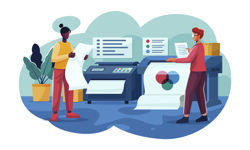Joan Scanlon, circulation & marketing director at Jane’s Information Group on marketing their online services.
Jane’s Information Group was founded in 1898 and provides information services, primarily to the defence sector. Since 1989, when they first launched a CD ROM, they have been providing information on multiple platforms. Now, the provision of online services is the most significant part of the Jane’s business.
Jane’s sees its online services as a premium offering and charge a premium price for it. Their firm policy (which they try really really hard not to break) is NOT to discount. Their USP is: why employ three or four researchers when you can rely on Jane’s to supply the information?
Their primary sales tool is face-to-face presentations. So the role of Joan’s marketing department is to increase awareness and generate interest – leading to the scheduling of a sales visit. As such, her team of marketers has to suppress some of their DM training and instincts and stop short of closure. Theirs is not a traditional call to action – more of a subtle prompt to get them to go to the web or arrange a sales presentation.
Lead generation
Lead generation is an important part of the process. All of the group’s print publications carry prominent pointers to the website and Jane’s produces a large number of free email alert services and newsletters. One challenge Joan faces is that thousands of prospects sign up for as many as three or four different email alert services. Why are these people not stepping up from free to paid service? Perhaps the email alerts need to be reassessed and the balance between hard information and taster adjusted in favour of the latter.
In the early days there was a heavy emphasis on free trial. This has since been curtailed because it is now thought that offering two or three month’s free access to a premium service does not send out the right message. A further difficulty they encountered was that even with a three month free trial, human nature meant that people were still not using it until the eleventh hour. Jane’s has now changed the process; if someone wants a free trial they have to call up and be qualified. Furthermore the trial is for one week only. The result is that they have far fewer, but much higher quality, trialists.
Peter Watkinson, group circulation manager, KHL Group on their experiences with digital editions.
KHL has been offering digital editions of their magazines for a couple of years. They publish B2B controlled circulation titles for the cranes and construction sectors. 80% of their combined circulations is overseas. Out of a total registered readership of 120,000 approximately 20,000 (and rising) have opted to receive a digital edition.
The reasons KHL embarked down the digital edition road were: increased profit (lower production and distribution costs), potential for added value to the advertiser (through rich media, interactivity and response measurement) and an enhanced reader experience (speed of distribution, archive and search functionality). KHL also felt that this was the direction publishing was headed and there were benefits to being an early mover. Their initial aim was not to generate revenue but to save costs, although Peter is convinced revenues will be generated in the medium term.
Digital copies audit
Their digital copies are audited and included within the headline figure on their BPA statement. Peter believes that ABC’s current policy of not allowing digital copies to be included in the headline figure is a major issue. The audit requires (whether ABC or BPA) certain pieces of information to be collected and stored and it was this that lead KHL to initially manage their digital registrations on a separate database. BIG MISTAKE according to Peter. Print and digital registrations must be managed on the same system, so publishers should put in the effort up front to ensure that their current system is compatible rather than creating a parallel fulfilment system. To do otherwise simply stores up problems for later and you will eventualy be faced with a major data migration issue.
Many of KHL’s initial fears proved unfounded. Takeup has been brisk, resolution has not been a problem and the reading experience has been ok. Noone pretends that it is easier to read from the screen, but evidence suggests that digital readers have a different kind of reading experience. Speed of download was also seen as a major hurdle but advances in file compression technology and the advent of broadband services has prevented this becoming an issue.
Peter highlighted two recent developments. Increasingly advertisers are pointing the link from their digital advertisement NOT to their website but to a specially designed micro-site. This is because it is generally assumed that any process that requires three or more clicks will lose the reader – they will simply click away. The other new feature is the fact that recent advances now allow digital readers to search across issues (assuming they have been archived in the same folder) and not just within issues. This further underlines one of the key USPs of digital – namely the information archive and retrieval functionality.
FEATURE
Cross media
On 9 September the Business Circulation Management Association (BCMA) held its inaugural event at the Westbury Mayfair Hotel in London. The theme was cross media activity. A number of prominent industry figures spoke about their experiences utilising new routes to market. Here, James Evelegh looks in more detail at the presentations of two of the speakers.










